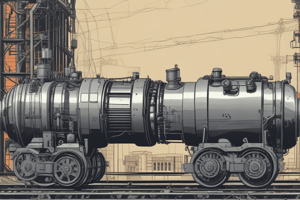Podcast
Questions and Answers
DC motors operate with alternating current (AC) and do not require an external power source.
DC motors operate with alternating current (AC) and do not require an external power source.
False (B)
AC Motors can only be squirrel-cage induction motors.
AC Motors can only be squirrel-cage induction motors.
False (B)
The interaction between the rotator and the stator's rotating magnetic fields is what produces torque in synchronous motors.
The interaction between the rotator and the stator's rotating magnetic fields is what produces torque in synchronous motors.
True (A)
DC motors have a stationary coil called a stator.
DC motors have a stationary coil called a stator.
The primary function of motors is to convert mechanical energy into electrical work.
The primary function of motors is to convert mechanical energy into electrical work.
Electromagnetic induction is not involved in the operation of motors.
Electromagnetic induction is not involved in the operation of motors.
In DC motors, the rotator is made up of multiple coils of wire wound around a flexible shaft.
In DC motors, the rotator is made up of multiple coils of wire wound around a flexible shaft.
AC motors use direct current to produce magnetic fields in both the rotator and stator.
AC motors use direct current to produce magnetic fields in both the rotator and stator.
Synchronous motors require an external source of DC current to function properly.
Synchronous motors require an external source of DC current to function properly.
Induction motors have an internal rotator called a squirrel-cage rotator made up of conductive bars connected in series.
Induction motors have an internal rotator called a squirrel-cage rotator made up of conductive bars connected in series.
Efficiency of motors is determined by the ratio of electrical power output to mechanical power input.
Efficiency of motors is determined by the ratio of electrical power output to mechanical power input.
Manufacturers are not concerned with improving motor designs to reduce energy consumption.
Manufacturers are not concerned with improving motor designs to reduce energy consumption.
Flashcards are hidden until you start studying
Study Notes
The Heart of Motion: Understanding Motors
Motors are the energy-converting, action-producing powerhouses that drive countless aspects of our daily lives. They convert electrical energy into mechanical work, enabling devices to move, rotate, or oscillate. In this article, we'll dive into the fundamental principles and inner workings of motors, shedding light on this crucial technology that has revolutionized the world.
Working Principles of Motors
Motors operate based on electromagnetic induction. This process involves alternating current (AC) or direct current (DC) passing through a wire, creating a magnetic field. When this magnetic field interacts with an external magnetic field, a mechanical force is generated, causing the motor's rotator to move.
There are two primary types of motors in common use:
-
DC Motors: These motors operate with direct current and require an external power source, such as a battery or DC power supply. They have a rotator (rotator armature) and a stator (stationary coils), and they produce continuous torque.
-
AC Motors: These motors operate with alternating current and can be either squirrel-cage induction motors or synchronous motors. Induction motors produce torque by utilizing the interaction between the rotator and the stator's rotating magnetic fields, while synchronous motors have a rotator that is driven to lock step with the rotating magnetic field of the stator.
DC Motors
DC motors consist of a rotator made up of multiple turns of wire wound around a flexible shaft. The stator contains permanent magnets or electromagnets that produce a magnetic field. When direct current flows through the rotator's wire, a magnetic field is produced, causing the rotator to rotate towards the north or south pole of the stator's magnets, depending on the polarity of the current flow.
AC Motors
AC motors use alternating current to produce magnetic fields in both the rotator and stator. The stator consists of multiple coils of wire arranged in a specific configuration to produce a rotating magnetic field. The rotator is made of conductive material, which interacts with the stator's rotating magnetic field, causing it to rotate.
Synchronous Motors
Synchronous motors have a rotator that rotates at the same speed as the rotating magnetic field of the stator, producing a perfectly synchronized rotation. This type of motor requires a precisely timed external source of AC current to function.
Induction Motors
Induction motors are the most widely used type of AC motor. They have an internal rotator, known as a squirrel-cage rotator, which is made up of conductive bars or rings short-circuited together. Induction motors produce torque by the interaction between the rotator and the rotating magnetic field of the stator, causing the rotator to rotate.
Efficiency and Performance
The efficiency of motors is a critical factor as it determines their effectiveness and energy usage. Efficiency is typically measured by the ratio of mechanical power output to electrical power input. Manufacturers are constantly improving motor designs to maximize efficiency, reduce energy consumption, and minimize heat production.
Motors play a vital role in various industries, from consumer electronics to automobiles, manufacturing, and renewable energy. Understanding their working principles and inner workings is essential for anyone interested in the world of technology and engineering.
Studying That Suits You
Use AI to generate personalized quizzes and flashcards to suit your learning preferences.





